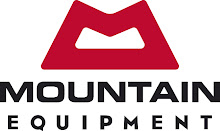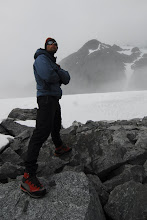The pink shadows of a rising sun creep down the granite fortresses that surround us. Morning in Yosemite Valley is so powerful. I jump from the car in front of Lower Cathedral and gorge myself on a view that has escaped my eyes for too long. El Cap roars from the meadows, a colossal wave of tiger striped gold. The feelings that surge through me are different, yet no less potent than those I felt six years earlier when I caught my first glimpse. One reaction remains the same and I feel it to my toes; it is very big and I am very small.

Kj, Paul, and myself are at the base of the Salathe before we know it. Although I haven't climbed a pitch of Yosemite granite for a few years, we are committed to beginning our climb that very day. Kj and Paul have never sailed these seas before and we are hungry for success. We climb the Freeblast that first day, our second climb ever together, and try to adjust our minds and bodies to what lies ahead. I enjoy the climbing, knowing that after today we will face the reality of crushing loads and a huge rack. We rap from Mammoth Terraces in the bright afternoon sun and start the crux which is existing in the Valley.

That night I lie awake, anxious about the day ahead. I am the only one of our team who has climbed El Cap. In fact, I've climbed a fair amount of walls in Yosemite, but never in such a heavy style. I came into wall climbing during the glory days of speed climbing. I can climb quickly, short fix, and tie a clove hitch. These are the very basic skills that have granted me passage in the past, but this will be different. I try to remember my systems from the few times I have hauled a bag. It's not that complicated, but yet, I know we will struggle.

The next day is spent gathering what we need for the wall. Food, ropes, water, rack, clothes, sleeping gear...it doesn't sound like much, but it all adds up. Late that afternoon we struggle to the base and begin to jumar frazzled fixed lines. Hauling the first ropelength is a typical nightmare of tangles and clusters. I try to stay psyched. I know this is a crux. Full loads hauled on a slab. It is the definition of pain.

We finally pull the pigs onto Heart Ledge and settle into a nice bivy, definetely the most comfortable of the route for us (we had no ledge and were forced to sleep in less than ideal spots due to crowding on the route). Our spirits rise with the elevation gained. I am so glad to be done with that portion of our adventure.
A stunning sun rise, a cup of coffee and we are off and running, er, well, shuffling. The first day is especially difficult for me. I try to lead quickly and haul like the Incredible Hulk so we can make our goal of El Cap Tower. I make a rookie mistake, forgetting to eat and hydrate like I should. I feel downright sick most of the day and am very relieved when we reach the Alcove as darkness falls. Another party occupys the classic ledge one pitch above, but they can have it. I'm fried. No matter what, El Cap will have it's way with you at some point or the other if you choose to throw yourself in its granite pan.
Clouds swirl about in the morning. The change of weather is a bit suprising really, but we pack our things and start the day. It doesn't take long for the sun to push it's way to the front of the sky and Kj and I soak in rays while Paul leads the second pitch of the day. We make good time to the block, actually catching up to the party in front of us. We decide to bivy at the block, but not after I use our ropes to fix a few pitches. Those four hundred feet of climbing are some of the best on the route for me. I feel the freedom of not having to haul the bags and surge up the enduro corner, free climbing quite a ways up the 5.11 pitch in my approach shoes. Hand jams in golden granite 2000 feet off the deck has me writhing in pleasure.

After an uncomfortable bivy, we set off to finish the climb. Before long I am fixing the ropes after leading the headwall. Long Ledge is quite crowded, and I am forced to construct an akward, but solid anchor. I notice the lines lay over the edge of the ledge, but conciously recognize how smooth the granite is at that point. The boys start jugging as I catch my breath. A few minutes later I take a look at the free line that Kj is jugging and notice a definete core shot that has developed. Holy crap! I recognize that the core is still intact. I know the rope is fine, that it will not break, but that doesn't stop me from exceeding my own strength and holding the rope off the ledge while Kj finishes ascending.

After taping the line, we settle into a long rest period. Long Ledge is a most spectacular hang and we soak it up, snacking and enjoying our incredible position. For the first time I concede mentally that we will make the top. We sure as hell aren't going down from here! This confidence doesn't ease the pain I feel in the off widths that gaurd the top, but we summit in time to watch the sun set. We revel in what we have accomplished as a team. I am truly proud of our effort. Although we all had definite strengths and weaknesses, the sum of our abilities was enough. I feel an especially overwhelming sense of gratitude seeing Kj on top. I knew how much he wanted this summit.

Personally, I gave my all on this wall. The hauling killed me. I am not a big guy, so hauling added a whole dimension of physical exertion that threatened to take hold of not only my muscles, but my brain. Although we did not over pack, I have never taken such a load up the Captain. No matter how you cut it, a team of three climbing for many days in the vertical environment will assure a full load. I'd like to say I'll never climb El Cap in this style again, but when you add up the laughs, triumphs, and disasters of an ascent of this sort, you realize that it was absolutely worth it...and that before long you'll be breaking your back again on the steely walls of El Capitan.





































